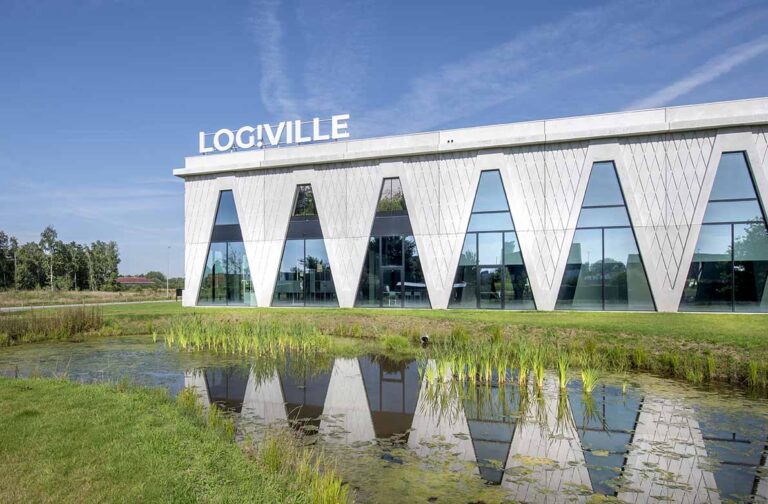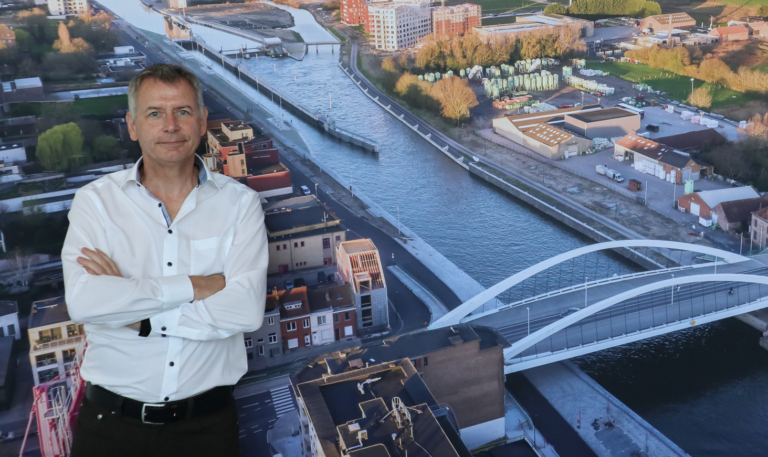Anne-Marie Van Asbroeck (imec): “People are moving away from the principle that autonomous vehicles should be able to do everything themselves”

“In the development and rollout of autonomous vehicles, the logistics sector has one of the most promising business cases,” says Anne-Marie Van Asbroeck, Director AI & Data at imec. For example, one could have trucks driving autonomously on the highway and ‘tele-operated’ the first and last mile. Flemish (and Dutch) stakeholders are playing a pioneering role in this. But imec also gathers particularly useful insights in other areas, such as digital interaction with infrastructure and with other vehicles, and what chips and sensors for mobility should look like tomorrow.
Imec originated 40 years ago as an independent research centre for micro- and later nanoelectronics. It has since grown into a top global player in the field of semiconductors. Initially, these were generic, but with time, development increasingly took into account specific application areas, such as automotive. “In that sector, advanced chips and powerful, accurate sensors are essential for the development of Advanced Driver-Assistance Systems (ADAS) and autonomous vehicles,” says Van Asbroeck.
In the development of autonomous vehicles, interaction with other road users as well as with infrastructure plays an increasingly important role. “Indeed, people are moving away from the principle that autonomy should only come from the vehicle itself. The sensors that OEMs build into their vehicles are important, but equally important is the information and data from the (digital) infrastructure, such as traffic lights. So, besides the vehicle manufacturers and their partners, there is also a role for the government in the development of autonomous vehicles,” she adds. But more on that later.
Full autonomy in question
“The strongest business cases for autonomous vehicles are found in logistics, where efficiency, safety and staff shortages are strong motivators. Incidentally, this is one reason why imec has been collaborating with VIL for some time to know where the greatest benefits lie, so that our research is done most efficiently.”
“When people think of autonomous vehicles, autonomous cars and vans in the city often come to mind first. However, this is unrealistic given the environment and the complex interaction with other road users such as pedestrians and cyclists. There are urban applications that could be considered, such as shuttles that follow a fixed route. However, in our opinion, autonomous trucks driving on the highway or at night are a much better business case. With them, the most profits can be made,” says Van Asbroeck.
‘Telecontrolled’
A good example is that of a truck driving autonomously on the motorway, controlled by a human only in the first and last kilometres. This can be done via ‘tele-operated’ (tele-driven) driving, where an operator sits remotely behind the wheel.
“You can more or less compare it to what Seafar does and developed in collaboration with imec: semi-autonomous driving. The barge – here admittedly still with a limited crew on board – operates partly autonomously by using advanced sensors such as radar, lidar and cameras, coupled with artificial intelligence algorithms. Operators ashore monitor and support the ship remotely. An operator can monitor several ships from the control centre.”
Flanders and the Netherlands are playing a pioneering role in the development of telecontrolled trucks, in which operators only take over the steering wheel of the autonomous truck in pre- and post-trip or unforeseen traffic conditions. For example, imec was actively involved in the international research project ‘5G-Blueprint’.
“In telecontrolled driving, it is indispensable that communication between the control centre and the truck is fast, safe, available and reliable at all times. Even when driving across borders, for example. This was researched and tested for three years by the consortium of 28 partners. It will still take some time before specific ‘use cases’ can be worked out, but the basis is there. And it is solid,” says Van Asbroeck.
You can see a video about the ‘5G-Blueprint’ project below.
Connected
As she pointed out earlier, they are moving away from the principle that autonomy should only come from the vehicle itself. In that case, it bases its driving behaviour only on data from its own cameras and sensors. Autonomous vehicles are much more likely to break through if there is also interaction with the other vehicles as well as with the environment (the infrastructure) through the mutual exchange of information and data.
This is the concept of the Cooperative, Intelligent Transport System (C-ITS). “In this case, we are already far advanced: Flanders – and the Netherlands – are frontrunners in this field. Applications have already been worked out in cooperation with the Agency for Roads and Traffic (AWV), in the Mobilidata programme. For example, connected vehicles and smart traffic lights can exchange information among themselves, allowing traffic to flow more smoothly,” Van Asbroeck explains.
Today (in Ghent, Hasselt and Roeselare) some 100 intersections are already equipped with C-ITS. By the end of this year, there will be 250. You can find out where these are being rolled out via the Mobilidata website. In Flanders, a total of about 1,800 intersections are eligible. Interaction is done via Be-Mobile’s Flitsmeister app, among others. When installed, the car or truck communicates with the traffic light and the app ‘tells’ it, for example, that it is 30 seconds away from turning green, so the driver knows whether to slow down or not, which can make traffic much smoother. The technology also makes it possible to start controlling traffic lights at intersections more dynamic and better coordinate traffic flows for all road users.
Very important stepping stone
“The system can also influence the traffic lights themselves, for example to prioritise emergency vehicles. It is already being used today by the Ghent fire brigade. When a fire engine drives out, the route is entered and the traffic lights are notified that it is on its way, so they are on green when it effectively drives by.”
She admits that C-ITS is primarily a mobility system today. “But there is a connection with autonomous driving. If you know in real time where there are traffic jams, roadworks or other delays, an autonomous vehicle can anticipate and respond. The traffic light can also report digitally that it is red, supporting the visual signal. It is an important stepping stone to the roll-out of autonomous vehicles: without C-ITS, its story will be much slower,” Van Asbroeck argues. In other words, the experience gained can greatly accelerate the development of communication between autonomous vehicles as well as with other digitalised infrastructure.
The importance of test programmes
In her point-of-view, gaining experience and carrying out many tests are therefore crucial for the eventual roll-out of autonomous vehicles. “Technically, a lot is already possible, but adoption is indeed taking longer than predicted. The focus of imec is therefore on accelerating this adoption. That is why we are developing test programmes to give the technologies more opportunities,” she says.
“However, testing for autonomous driving requires a lot of organisation and energy,” she adds. “Drawing up test plans and providing safety audits – both at the vehicle and on the roads – are necessary to get permission to test on public roads. In doing so, it is necessary to develop targeted test beds that offer sufficient variety (city, highway, industry, port, etc.), size (at least 500 km of sections) and the necessary challenges (e.g. cross-border). Moreover, they should also realise strong partnerships between industry, government and knowledge institutions to attract and test the necessary investments and technology in the low countries.”
Digital transformation of mobility
Imec therefore works closely with the OEMs and their partners to know their needs better and thus research and test them in the most focused way possible. In the same vein, there are also intensive contacts with other stakeholders, such as VIL, to gain relevant insights and make the right decisions.
“So by connecting the different stakeholders – private companies, government and logistics sector -, sharing knowledge and exchanging data, imec can create a favourable climate to test different technologies and thus also attract investments in these technologies to Flanders. In this way, we get a clear picture of what is needed to accelerate the development of autonomous vehicles and can create a Flemish ecosystem that enables the digital transformation of mobility – in the broad sense of the word. This is how Flanders can become a European leader in connected and autonomous driving,” she concludes.
Smart Vehicles
‘Smart Vehicles’ will be the subject of the new Thematic Tours at Log!Ville from 29 April to 27 June 2024. These Thematic Tours will explore opportunities to future-proof trucks and vans. These include autonomous driving, safety and measurement sensors, telematics hardware, connectivity, battery-electric silent deliveries, and more.
Read more information below.



